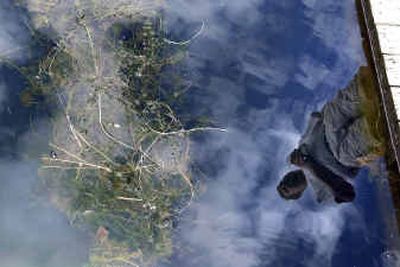Mystery milfoil in Lake CdA

An unidentified species of milfoil is now infesting hundreds of acres in the southern end of Lake Coeur d’Alene, according to a scientist with the Coeur d’Alene Tribe.
Although the plant resembles Eurasian milfoil – an invasive species that ruins fish habitat, tangles propellers and robs water of precious oxygen – a positive identification has not yet been established, said Robert Matt, director of the tribe’s lake management program. Specimens have been sent to the University of Connecticut for genetic testing.
“Their initial thoughts are that this is a hybrid, which is becoming pretty common across the United States,” Matt said, adding that hybrids are often more resistant to herbicides than even Eurasian milfoil.
Whatever it is, the plant has “incredible potential to proliferate itself,” Matt said. “It’s much more widespread than we were aware of.”
Eurasian milfoil has been found in Spirit, Hayden and Pend Oreille lakes. Washington is home to 107 lakes and rivers with milfoil, according to the state’s Department of Ecology. Eradicating the weed is nearly impossible.
Lake Coeur d’Alene is Idaho’s most heavily fished lake and a top tourist destination. The presence of the weed would be cause for “significant concern,” Matt said. The fast-growing weed can fill shallow bays and its biomass can upset fragile nutrient cycles. Scientists also are looking into the interaction between aquatic plants and the heavy metals-laden mine sediment on the lake’s bottom. When the plants decompose, they use oxygen from the lake.
“We don’t know enough about it to know if there’s a big effect on the nutrient cycle in the lake,” Matt said. “We need to look very hard at all the possible relationships that exist out there. Our other concern is that the south end of the lake becomes unusable for recreation. … We’re concerned that 10 years from now you may not be able to swim or boat in a large part of the southern end.”
All it takes to spread the plant is for a fragment to become stuck on a propeller and taken to another body of water.
Kootenai County Weed Superintendent Nina Eckberg cautioned against becoming too concerned about the mystery milfoil. “There’s nothing that’s been confirmed yet,” she said, but added that she would be working closely with the tribe to learn more about the plant.
Eckberg accompanied a scientist with the tribe during a weed exploration cruise last month. “I was alarmed when I saw how much milfoil – and I’m saying that generally – was at that end of the lake,” she said.
Native species of milfoil also grow in local lakes, Eckberg said. Unlike the Eurasian variety, however, the native milfoil is controlled by natural predators and does not take over large swaths of lake bottom.
In Lake Coeur d’Alene, the mystery milfoil is “the only plant growing” in hundreds of acres, said Matt, with the Coeur d’Alene Tribe. The tribe checked shallow portions of much of the lake’s southern third over the summer. The northern reaches of the lake, near the city of Coeur d’Alene, is deeper and rockier and considered less-than-prime habitat for undesirable milfoil.
The work has been called off for the season because of the start of the lake’s annual drawdown, Matt said. The tribe hopes to continue studying and mapping the plant’s location next summer.
“What we don’t know is how long it’s been in the lake and the full extent where it grows,” Matt said. “We want to move up the lake and study in similar bays.”